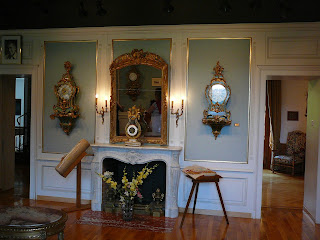After a
great morning and lunch at Greubel Forsey, we headed off for a special
afternoon of touring the Musee de L’horlogerie du Locle, Chateau des Monts with
Phoebe Forsey.
Situated in
the midst of rolling lawns and an English style garden the Chateau du Monts was
inaugurated as the Musee d’Horlogerie Du Locle in 1959. A long history of watch
making is associated with the Chateau dating back to Samuel DuBois. In the
early 1900’s the Chateau was bought by Georges Ducommun the founder of DOXA. Upon his death it passed
to his daughter Helene Nardin who in turn sold it the town of Le Locle.
The watch
museum came about when the watch component of a curio collection was transferred
to the Watchmaking School. After being
stored away during the Second World War, a group of horological enthusiasts set
about reviving the Watch Museum. A permanent location became available when the
town bought Chateau des Monts from Mme Nardin. Five years after the purchase
and restoration, the museum welcomed its first visitors.
Since it’s
inauguration the Museum has had its collection enlarged with the generous
bequests of Maurice Yves Sandoz (primarily pieces from his automaton
collection), Alfred Huguenin (Neuchatel clocks), Henri Jeanmarie (clocks and
furniture decorated with the Boulle marquetry ) and Frederic Savoye (a
collection of French and Swiss clocks).
Some of the
automata found in the Maurice Yves Sandoz Room:

Examples of
Neuchatel Clocks in the Alfred Huguenin Room:

Another permanent exhibition is The Times Of Time. This thematic exhibition, deals with the human comprehension and measurement of time. Shown in a modern setting, with separate and distinct chapters, it not only deals with the industry preoccupation of measuring time, but also with calendars and chronologies and non- mechanical methods of time telling such as hourglasses and sundials.
On temporary exhibit at the time of our visit was Automates & Merveilles au Locle :
Chefs-d’œuvre de luxe et de miniaturisation (Automata and marvels: Masterpieces of luxury and miniaturisation). A joint exhibition between Musee d'art et d'histoire de Neuchatel, Musee International d'Horlogerie La Chaux-du-Fonds and Musee D'Horlogerie Du Locle. This exhibit focused on the work of three leading figures in 18th century clockmaking: Pierre Jaquet-Droz, his son Henri-Louis and their associate Jean-Frédéric Leschot. The exhibition at Le Locle focused on the miniaturisation aspect of watchmaking and the luxurious, playful and often whimsical creations.
Chefs-d’œuvre de luxe et de miniaturisation (Automata and marvels: Masterpieces of luxury and miniaturisation). A joint exhibition between Musee d'art et d'histoire de Neuchatel, Musee International d'Horlogerie La Chaux-du-Fonds and Musee D'Horlogerie Du Locle. This exhibit focused on the work of three leading figures in 18th century clockmaking: Pierre Jaquet-Droz, his son Henri-Louis and their associate Jean-Frédéric Leschot. The exhibition at Le Locle focused on the miniaturisation aspect of watchmaking and the luxurious, playful and often whimsical creations.
Henri-Louis Jaquet-Droz’s Le Dessinateur (The Draughtsman) was the centre piece for the theme of miniaturization. Along with the Jaquet-Droz’s, other master clockmakers and craftspeople were featured in the exhibition revealing the relations that existed between them. The miniaturization of mechanisms allowed the clockmakers to put singing birds, music boxes or animated scenes in all sorts of objects (watches, pistol, cages, snuff boxes). They also excelled in creating android automata and small mechanical animals. Having seen the movie Hugo, Vikki and I were really excited by this exhibition.
Unfortunately photography was not allowed in this exhibit. I have included the link Automates & Merveilles for futher reading and photographs.
While the museum is primarily focused on timepieces, they have also included samples of other crafts of the region. During the winter while their husbands were working on the watches and clocks, the women folk were occupied in making lace and other textile crafts. On display are various samples of lace and the equipment used in its manufacture.
Below next to the fireplace are two examples of lace making apparatus:
Our visit of this well presented museum and its collection was a rare treat. Having Phoebe Forsey with her in depth knowledge of the collections to guide us through the museum was a wonderful highlight to our visit.
We would like to thank Stephen and Phoebe Forsey and Greubel Forsey for organising our visit to Musée d'Horlogerie du Locle, Château des Monts.










No comments:
Post a Comment